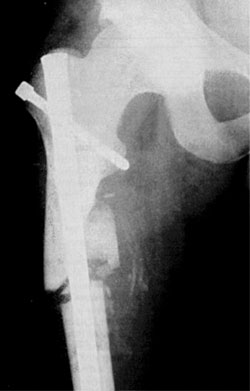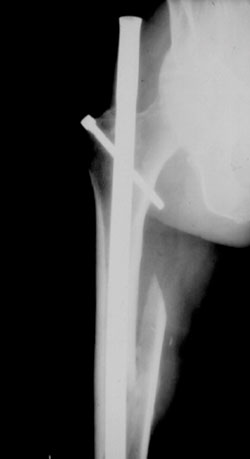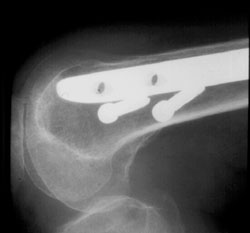Treating femoral fractures with intramedullary rods is safe but tricky
While antegrade nailing is best for most cases, retrograde nailing is beneficial for select patients.
by Richard F. Kyle, MD
Inserting an intramedullary rod is a vital and effective management approach to treating femoral shaft fractures, but there are tips and tricks a surgeon should follow to ensure better results.
To start with, both retrograde and antegrade nails can pose challenges if you do not use correct starting points. In some cadaver studies, researchers have found that we can cause damage to abductor musculature and external rotators when we ream proximally for large-diameter nails. This is particularly true with second-generation nails when the proximal aspect of the nail is larger than 16 mm and requires reaming proximally to accommodate the larger nail diameter starting points. In most cases, the piriformis fossa is the ideal starting point for an antegrade nail, since it allows alignment of the nail with the normal anterior bow of the femur.
|
|
When you use a second-generation nail, however, the starting point should be slightly anterior to the piriformis fossa to accommodate anteversion of the femoral neck and entrance of the proximal screw into the femoral neck. A trochanteric starting point may be used, but it is important not to start too far laterally. If this occurs, excessive reaming of the lateral cortex and potential fracture of the medial cortex may occur with introduction of the nail.
For a lateral starting point, you should start at the tip of the greater trochanter. All of these starting points are within 7 mm to 8 mm of each other. This necessitates absolute accuracy with your starting point, depending on the type of nail used.
The accuracy of the starting point is further necessitated because of the rigidity of our current interlocking nails. To assure that the interlocking nails are strong enough to accommodate the stress riser of the interlocking holes, the wall thickness of the nails has been increased, thus increasing the rigidity of the nails.
|
Images: Kyle RF |
The piriformis fossa is the best starting point from a mechanical standpoint because it sits in line with the femoral canal, but by starting there you may increase the risk of damage to the medial circumflex artery. This is a concern in the younger patient.
With the use of second-generation nails, the starting point must be moved 2 mm to 3 mm anterior to accommodate introduction of the proximal screws into the femoral neck. The trochanteric portal avoids injury to the vascular proximal femur but may cause problems if the starting point is too lateral. It tilts the hip into varus, causing mechanical problems, and it may cause blowout of the medial cortex with the introduction of a rigid nail.
Neck slope
The femoral neck is sloped from anterior to posterior. If your C-arm image shows you are starting the guide wire on the superior aspect of the neck on the anteroposterior view, your starting point is too far anterior. To start in the piriformis fossa, the guide pin should appear to be 7 mm to 8 mm below the superior-most aspect of the neck.
It is important to preoperatively plan and match the bow of the nail to the bow of the femur. Some nails are very straight in terms of their bow and should always be templated using a lateral image of the femur to make sure that you are in the ballpark with the bow of the nail matching the bow of the femur. This is particularly true in some older patients and those of Asian descent who have a more severe bow. This is also true in some patients who have a deformity from prior fractures.
If the bows do not match and you have only one implant to choose from, it may require more reaming to accommodate the nail in the canal. As a general rule of thumb, if the bows are quite congruent, you should ream 1 mm larger than the diameter of the nail you are using. If there is a bow mismatch, reaming of 1.5 mm to 2 mm greater than the shaft diameter is not uncommon.
Placing proximal locking bolts
|
|
Placing proximal locking bolts and interlocking nails is uncomplicated because of the accuracy of the proximal locking jigs. To assure proper use, the jigs must be securely attached to the nail, and this must be checked during the impaction process so they do not work loose prior to proximal locking.
It is also critical to obtain a lateral X-ray after locking the proximal locking bolt to assure that the locking bolt truly goes through the hole in the nail and not anterior or posterior to the nail.
Distal locking is done using a freehand approach with a C-arm to guide the locking technique. A C-arm should be used to assure that the hole in the nail is perfectly round, and on most C-arms, this can be magnified to ease visualization.
I use a drill with a very sharp tip. The tip of the drill is placed in the center of the hole on the C-arm image. It must be dead center on the image to assure accurate targeting. The angle of the drill after dead-center placement is aligned with the angle of the C-arm. Carefully drill across the femur through the first hole. The drill is then removed, and a lateral image is taken to assure that the drill is in the center of the hole — the position of the drill is confirmed. The far cortex is then drilled prior to insertion of the locking bolt.
Again, taking a lateral image after insertion of the locking bolt is absolutely necessary to confirm that the locking screw did not go anterior or posterior to the nail.
If the curvature of the nail is mismatched with the curvature of the femur and the nail is relatively straight, it may penetrate anteriorly. Again, prior to the insertion of the nail, you must look at the bow of the femur to make sure that it approximately matches the bow of the nail. If there is a mismatch, there may be a concern that the nail will penetrate anteriorly if you use too long a nail. There is also concern when placing the cross bolt in the far anterior cortex that notching of the femur with subsequent fracture may occur.
Again, on finishing the nailing process, a good lateral image is necessary both proximally and distally to make sure that the locking bolts are in the correct positions.
Retrograde nailing
|
|
Retrograde nailing is a popular technique in femoral fracture fixation.
In nailing supracondylar fractures, the surgeon must ensure that good distal purchase of the nail can be made in the remaining supracondylar region. Access to the starting point through the knee is relatively easy with a retrograde nail.
The patient is placed in the supine position with the knee over a radiolucent triangle. A 3-cm medial parapatellar incision is made and guide wires are placed through the incision in alignment with the distal femur. Blumenstadt’s line is used to identify proper placement of the K-wire.
A K-wire is placed on the lateral image at the anterior aspect of Blumenstadt’s line in alignment with the lateral canal of the femur. The K-wire is aligned with the axis of the femur on the AP radiograph. The K-wire is driven into the distal end of the femur, and a drill is used to open the distal end of the femur. The fracture is reduced and the reaming wire is placed across the fracture site. The canal is reamed to 1 mm larger than the nail to be used.
Again, if there is a mismatch between the bow of the femur and the bow of the nail, over-reaming may be necessary. In general, longer retrograde nails are used and the proximal end of the nail should be just proximal to the lesser trochanter.
Distal targeting is fairly easy because the jigs work well. The jig must be firmly attached to the nail — both anteroposterior — and lateral imaging must be used to assure proper placement of the distal locking screws.
Proximal locking using a retrograde technique uses a freehand approach. A major concern with this approach, however, is loss of the screw into the posterior aspect of the thigh. Locking occurs from anterior to posterior in this application.
Most manufacturers now produce a screwdriver that captures the screw. If you do not have access to a screw-capturing screwdriver, a suture may be placed about the screw so it can be retrievable if it is lost into the posterior aspect of the thigh.
Antegrade nailing: Still the best
Antegrade nailing is still the gold standard in my opinion. Although studies have shown the union rate and malunion rate are comparable between antegrade and retrograde nailing, it is more difficult to revise a retrograde nail. A retrograde nail can migrate anteriorly, and removing it results in damage to the patellofemoral groove of the knee.
Indications for retrograde nailing are multiple trauma cases to facilitate rapid nailing of the femur, obesity and an ipsilateral tibial shaft and femoral shaft fractures.
In conclusion, establishing a proper starting point for intramedullary rodding is critical. It is the single-most important aspect of this surgery. When using interlocking nails, it is essential to take both good anteroposterior and lateral X-rays to assure proper placement of the interlocking bolts.
![]()
- Richard F. Kyle, MD, can be reached at Hennepin County Medical Center, Department of Orthopaedic Surgery, MCG2, 701 Park Avenue, Minneapolis, MN 55415-1829; 612-873-4220; e-mail: richard.kyle@hcmed.org.










